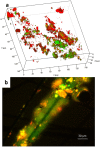Anaerobic oxidation of methane coupled with extracellular electron transfer to electrodes
- PMID: 28698657
- PMCID: PMC5506047
- DOI: 10.1038/s41598-017-05180-9
Anaerobic oxidation of methane coupled with extracellular electron transfer to electrodes
Abstract
Anaerobic oxidation of methane (AOM) is an important process for understanding the global flux of methane and its relation to the global carbon cycle. Although AOM is known to be coupled to reductions of sulfate, nitrite, and nitrate, evidence that AOM is coupled with extracellular electron transfer (EET) to conductive solids is relatively insufficient. Here, we demonstrate EET-dependent AOM in a biofilm anode dominated by Geobacter spp. and Methanobacterium spp. using carbon-fiber electrodes as the terminal electron sink. The steady-state current density was kept at 11.0 ± 1.3 mA/m2 in a microbial electrochemical cell, and isotopic experiments supported AOM-EET to the anode. Fluorescence in situ hybridization images and metagenome results suggest that Methanobacterium spp. may work synergistically with Geobacter spp. to allow AOM, likely by employing intermediate (formate or H2)-dependent inter-species electron transport. Since metal oxides are widely present in sedimentary and terrestrial environments, an AOM-EET niche would have implications for minimizing the net global emissions of methane.
Conflict of interest statement
The authors declare that they have no competing interests.
Figures





Similar articles
-
Enhanced Extracellular Electron Transfer in Magnetite-Mediated Anaerobic Oxidation of Methane Coupled to Humic Substances Reduction: The Pivotal Role of Membrane-Bound Electron Transfer Proteins.Environ Sci Technol. 2024 Oct 8;58(40):17756-17765. doi: 10.1021/acs.est.4c05543. Epub 2024 Sep 25. Environ Sci Technol. 2024. PMID: 39323212
-
Study on performance and mechanisms of anaerobic oxidation of methane-microbial fuel cells (AOM-MFCs) with acetate-acclimatizing or formate-acclimatizing electroactive culture.Bioelectrochemistry. 2023 Jun;151:108404. doi: 10.1016/j.bioelechem.2023.108404. Epub 2023 Feb 21. Bioelectrochemistry. 2023. PMID: 36842363
-
Metal-dependent anaerobic methane oxidation in marine sediment: Insights from marine settings and other systems.Sci China Life Sci. 2019 Oct;62(10):1287-1295. doi: 10.1007/s11427-018-9554-5. Epub 2019 Jun 14. Sci China Life Sci. 2019. PMID: 31209798 Review.
-
Humic substances as electron acceptor for anaerobic oxidation of methane (AOM) and electron shuttle in Mn (IV)-dependent AOM.Sci Total Environ. 2024 Feb 20;912:169576. doi: 10.1016/j.scitotenv.2023.169576. Epub 2023 Dec 23. Sci Total Environ. 2024. PMID: 38145665
-
Anaerobic oxidation of methane driven by different electron acceptors: A review.Sci Total Environ. 2024 Oct 10;946:174287. doi: 10.1016/j.scitotenv.2024.174287. Epub 2024 Jun 28. Sci Total Environ. 2024. PMID: 38945238 Review.
Cited by
-
Mechanisms of extracellular electron transfer in anaerobic methanotrophic archaea.Nat Commun. 2024 Feb 17;15(1):1477. doi: 10.1038/s41467-024-45758-2. Nat Commun. 2024. PMID: 38368447 Free PMC article.
-
Genome-Scale Mutational Analysis of Cathode-Oxidizing Thioclava electrotropha ElOx9T.Front Microbiol. 2022 Jun 10;13:909824. doi: 10.3389/fmicb.2022.909824. eCollection 2022. Front Microbiol. 2022. PMID: 35756027 Free PMC article.
-
Evidence for Horizontal and Vertical Transmission of Mtr-Mediated Extracellular Electron Transfer among the Bacteria.mBio. 2021 Feb 22;13(1):e0290421. doi: 10.1128/mbio.02904-21. Epub 2022 Feb 1. mBio. 2021. PMID: 35100867 Free PMC article.
-
Physiology and Distribution of Archaeal Methanotrophs That Couple Anaerobic Oxidation of Methane with Sulfate Reduction.Microbiol Mol Biol Rev. 2019 Jul 31;83(3):e00074-18. doi: 10.1128/MMBR.00074-18. Print 2019 Aug 21. Microbiol Mol Biol Rev. 2019. PMID: 31366606 Free PMC article. Review.
-
Suppressing peatland methane production by electron snorkeling through pyrogenic carbon in controlled laboratory incubations.Nat Commun. 2021 Jul 5;12(1):4119. doi: 10.1038/s41467-021-24350-y. Nat Commun. 2021. PMID: 34226558 Free PMC article.
References
-
- Elvert M, Boetius A, Knittel K, Jørgensen BB. Characterization of Specific Membrane Fatty Acids as Chemotaxonomic Markers for Sulfate-Reducing Bacteria Involved in Anaerobic Oxidation of Methane. Geomicrobiology Journal. 2003;20:403–419. doi: 10.1080/01490450303894. - DOI
Publication types
MeSH terms
Substances
LinkOut - more resources
Full Text Sources
Other Literature Sources
Miscellaneous

